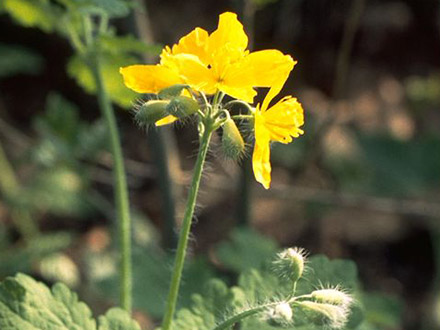Botanical name
Chelidonium majus L.
Family
Papaveraceae
Common name
Celandine, Tetterwort, Killwort, Wart-wort.
Information about the plant
Chelidonium majus is the only species of the genus Chelidonium. It is native to regions from subarctic to Mediterranean Europe and also grows in the temperate and subarctic regions of Asia. Celandine was probably introduced in North America. It is a typical ruderal plant, i.e. it grows in human-disturbed areas such as rubble, garbage sites, and waste yards, along paths and roadsides, as well as hedges, walls, fences, fields, and pastures. Due to their sweet, sticky seed appendage (elaiosome), seeds easily stick to ants and, therefore, frequently found in wall crevices.
The genus name Chelidonium comes from the Greek"chelidon" (= swallow), but it is not entirely clear how this is interpreted. Theophrastus, the Greek philosopher and scientist, associated it with the observation that the plant begins to bloom with the arrival of the swallows, and it withers with their departure. That may be true in Greece, where the celandine certainly flowers earlier than here, where it blooms after the arrival of the swallows, but typically throughout the entire summer from May to September. It is very characteristic that on a plant that is already withering, there are still yellow flowers next to the already ripe pods. Another interpretation is found in Pliny, who fables that swallows use the flowers to restore the eyesight of their young. The English name is a linguistic transformation of the Latin name, originally "celandine" (from Chelidonium).
The plant's bright yellow flowers are one of its most distinctive features, which attract a variety of pollinators. Celandine has also been used historically in traditional medicine for its purported healing properties. It was believed to aid in treating warts, which is why one of its common names is wart-wort. The latex, the orange milky sap, found in the plant was applied directly to the skin to help remove warts and other skin ailments.
Celandine is a 30 to 60 cm tall perennial with branched and protruding hairy stems. It has unpaired, pinnate leaves, light green on top, and blue-green with a frosted appearance underneath. The flowers consist of four bright yellow petals and numerous stamens. The ovaries develop into approximately 5 cm long narrow pods with many small black seeds, which bear the above-mentioned whitish, sweet and sticky appendage (elaiosome), with which the seeds are easily and widely dispersed by animals. In all parts of the plant there is an orange-colored milky sap, which is released when the plant is broken, even when picked, and stains the fingers yellow. The color is caused by carotenoids and some alkaloids in the latex, like sanguinarine (Lat sanguis = blood).
Medicinally used parts of plants (herbal drug)
The dried herb consisting of leaves, flowers, and stems collected during flowering time is used. The commercially available drug comes mainly from Eastern Europe.
Constituents of the herbal drug
Celandine contains alkaloids, principally of the benzylisquinoline type (e.g. coptisine)
Quality of the drug
The quality of celandine herb (Herba Chelidonii) is specified in the European Pharmacopoeia. (Ph. Eur.).
Medical applications
Recognised medical use
The HMPC had previously intended to classify celandine as a traditional medicinal product. After weighing up the risk-benefit ratio, the HMPC published a statement advising against the use of celandine preparations due to adverse effects on the liver (see also under ‘Notes’).
ESCOP: For the symptomatic treatment of mild cramps in the upper gastrointestinal tract and mild biliary complaints, as well as dyspeptic complaints such as flatulence and bloating.
Traditional use
Celandine has no listing as a traditional medicine (Article 16a of Directive 2001/83/EC).
Herbal drug preparations in finished dosage forms
- Powdered celandine in coated tablets.
- Dry extracts in tablets.
- Alcoholic extracts in drops.
- Chelidonium majus homeopathic mother tincture in drops.
Dosage
Prepared drugs: see patient information leaflet.
Tea: The application of celandine herb as a tea is not recommended due to possible side effects.
Preparation of a tea
Not applicable.
Notes
Celandine should not be taken with an existing or history of liver disease, nor in the case of gallstone disease or obstruction of the bile ducts.
It is not recommended to take celandine during pregnancy and lactation, as no safety studies are available to date. This also includes the use of celandine in children and adolescents under the age of 18.
Side effects
Reports of increased liver enzyme activity in serum bilirubin and jaundice have put the application of celandine temporarily in question. However, research results have linked this side effect to high daily alkaloid doses (15 to 25mg). Excessively high doses of the alkaloids sanguinarine and chelerythrine, mainly found in the roots, could also be responsible. It was also found that in said cases, the celandine preparations were incorrectly applied during acute liver and biliary inflammation. After discontinuing the use of celandine, these values decreased. Today, it is estimated that no side effects are expected with a total daily alkaloid dose of up to 2.5mg.
Based on the data available on celandine, the HMPC categorizes the risk-benefit ratio as negative. There are safer herbal medicinal products available for this indication.
Interactions
None known.
References
Herbal drug monographs
HMPC (2012), ESCOP (2003), WHO (NIS)
Further literature
Commentary on the European Pharmacopoeia (Celandine, No. 1861)


